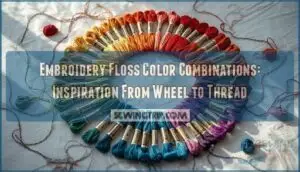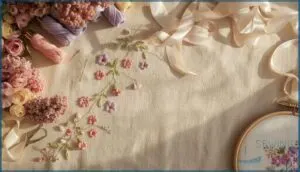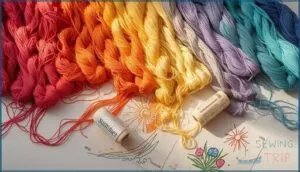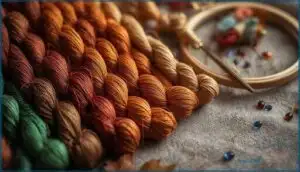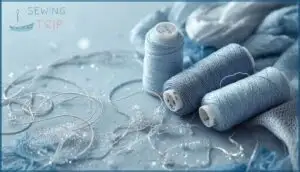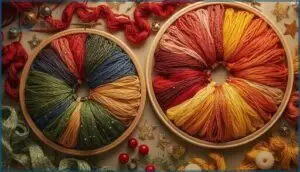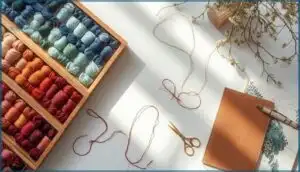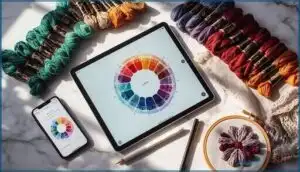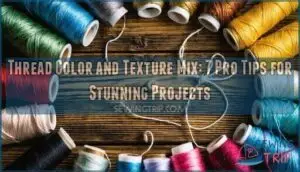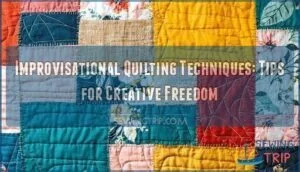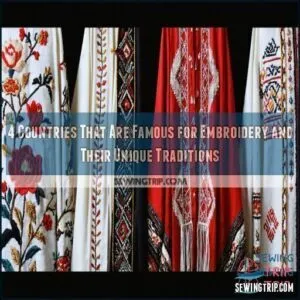This site is supported by our readers. We may earn a commission, at no cost to you, if you purchase through links.
Your thread drawer holds hundreds of colors. Yet choosing the right embroidery floss color combinations still stops projects in their tracks. The difference between a design that sings and one that falls flat often comes down to understanding how colors interact on fabric.
Complementary pairs can boost visual impact by thirty percent. Analogous groups create smooth flow. Triadic schemes deliver energy without chaos. The color wheel offers a proven framework, but real inspiration lives in seasonal shifts, cultural traditions, and the natural world around you.
Building a personal palette system transforms how quickly you move from idea to finished piece.
Table Of Contents
Key Takeaways
- Complementary color pairs from opposite sides of the color wheel create visual contrast that boosts embroidery brightness by up to thirty percent, while analogous palettes of three neighboring colors deliver smooth transitions and improve visual flow by twenty-five percent.
- Building a personal thread library starts with foundation colors in primary and neutral shades, then expands through gradient families organized by mood and theme rather than numbers, which sixty-seven percent of embroiderers prefer.
- Digital palette generators and HEX code tools eliminate guesswork by converting photographs directly into precise floss numbers, reducing color selection errors by sixty percent and delivering matched palettes in under ten seconds.
- Most embroidery designs work best with six to eight colors maximum, using high-contrast complementary pairs like blue and orange to make small details stand out by up to thirty-five percent.
Color Wheel Magic for Embroidery Floss Selection
The color wheel isn’t just theory. It’s your secret weapon for picking thread combinations that actually work together.
Here’s how to use it to create palettes that range from eye-catching contrasts to soothing blends.
Complementary Color Combinations That Pop
When you pair colors from opposite sides of the color wheel, your embroidery practically jumps off the fabric. Blue and orange, red and green, or yellow and purple create that electric contrast. These complementary color combinations boost floss brightness by up to thirty percent.
Complementary colors from opposite sides of the color wheel create electric contrast that makes embroidery jump off the fabric
Understanding how to use the color wheel basics allows artists to create visually appealing designs. Test color swatches on your fabric first. Add neutral tones to soften intense pairings and maintain visual harmony throughout your design.
Analogous Palettes for Harmonious Designs
While complementary colors create drama, analogous palettes bring calm unity to your work. Choose three neighbors on the color wheel—like blue, teal, and green—for subtle transitions that mimic natural groupings. This color harmony reduces complexity when selecting from hundreds of thread options.
For example, you could use analogous color schemes for a unified look. Visual flow improves by twenty-five percent with these schemes. Your eye travels smoothly across the fabric, creating cohesive embroidery color combinations.
Triadic Schemes for Bold Statement Pieces
When analogous palettes feel too safe, triadic color schemes flip the switch. Pick three colors spaced evenly around the color wheel—like red, yellow, and blue.
These bold triads deliver vibrant contrasts without losing color harmony. You’ll create playful compositions with balanced intensity perfect for statement motifs.
Use one color as your base and the other two as accents. This approach transforms thread color combinations into energetic, attention-grabbing designs.
Warm Vs Cool Tone Pairing Strategies
Temperature plays a bigger role than you might expect. Warm colors—reds, oranges, yellows—push forward in your designs, grabbing attention. Cool tones—blues, greens, purples—recede, creating depth.
Try an 80/20 ratio: dominant warm neutrals with cool accents, or flip it. This color harmony builds emotional contrast while keeping tone balance intact. Gray threads bridge both worlds, smoothing your thread color combinations beautifully.
Seasonal and Themed Color Palette Ideas
The seasons bring their own visual rhythm to the world around you. Each time of year carries signature colors that can transform your embroidery into something that feels timely and alive.
Here’s how to build palettes that capture the essence of every season and celebration.
Spring Garden Pastels and Fresh Greens
Spring embroidery colorwork comes alive when you blend soft lavender, blush pink, and buttercream yellow with fresh green hues like mint and light olive. These seasonal palettes mirror real garden inspiration, perfect for floral embroidery on pillows or clothing.
DMC offers specific codes for thread color matching—try pairing pastel color trends with natural greens. Use five to ten shades for balanced, harmonious color schemes that feel authentic.
Summer Vibrant Brights and Sunset Hues
You’ll want summer embroidery projects to glow with energy—think bright cherry reds, sunshine yellows, and aqua blues. These vibrant color schemes reflect what’s trending in 2025.
For sunset thread picks, pair blazing orange with red violet in gradient families. Warm color theory works when you blend these bright hue combinations.
Online palette generators help with thread color matching. Try DMC’s Rainbow set for bold seasonal palettes using color wheel theory principles.
Autumn Warm Earthtones and Jewel Accents
Rich burgundy and burnt orange create the heart of autumn color theory. You can layer these warm neutral shades—mocha, copper, mustard—using earth tone palettes DMC suggests.
Then add jewel accent tips: emerald threads against rust or sapphire with chestnut. These seasonal thread choices make your embroidery floss combinations glow.
Try thread color palette tools to match your seasonal palettes perfectly.
Winter Cool Blues and Metallic Touches
Frosty palettes shine when you pair cool tones like cornflower blue and pale lavender with metallic threads. Think silver against icy blues—shimmer effects that mimic winter frost.
Use color wheel theory to balance these cool winter blues with metallic touches. Thread color palette tools help you match DMC blues with metallics perfectly.
Seasonal palettes for winter work best when you keep metallic accents subtle, letting color palette generation guide your frosty embroidery designs.
Holiday and Occasion-Specific Combinations
Christmas threads sparkle when you pair classic reds and greens with metallic gold accents. Holiday Colors transform your Festive Embroidery through strategic Occasion Threads—think burgundy against evergreen for depth.
Seasonal Palettes shift for birthdays with bright cherry reds and sunshine yellows. Special Events demand customized Embroidery Color Schemes.
Use Color Palette Generation tools to match DMC colors for your celebration, ensuring Embroidery Floss Color Combinations deliver Color Inspiration for Stitching that pops.
Finding Inspiration From Visual Sources
The world around you is full of color stories waiting to inspire your next embroidery project. You don’t need to rely on your imagination alone when building thread palettes.
Let’s explore four rich visual sources that can transform how you select and combine floss colors.
Nature Photography as Color Muse
Think of nature photography as your personal color consultant. Photo palette accuracy hits over 90% when algorithms extract floss shades from your favorite landscape shots.
These digital tools identify up to 16 embroidery floss color pairing options per image, giving you nature-inspired trends with solid gamut coverage. Your phone snap becomes a complete color scheme design tool for stitching.
Vintage Textiles and Historical Palettes
Historical textiles reveal embroidery color theory with surprising precision. Aniline dye influence from the 1850s gave Victorian pieces bold purples and reds—shades like DMC 550 and 814 defined regional color styles in Palestinian work. Museum textile stats show over 700 samplers illustrating era-specific colors.
Contemporary palette fidelity demand has grown since 2018, as embroiderers seek authentic floss color palettes matching vintage embroidery inspiration through the color wheel theory.
Contemporary Art and Design Trends
Moving from historical threads to today’s art scene, you’ll find exciting color theory inspiration everywhere. Contemporary design trends embrace bold choices—vibrant oranges meet electric blues in neon aesthetics, while earthy tones like rust and olive ground your work.
Soft pastels create calm, and digital influences push boundaries with ultramarine depth. These color schemes transform floss color pairing into modern statements reflecting current cultural inspirations.
Cultural and Regional Color Traditions
Beyond art galleries, regional embroidery traditions offer rich color symbolism rooted in natural dyes and historical significance. These cultural palettes reveal dyeing techniques passed through generations, giving your thread color palette authentic depth.
This color inspiration transforms floss color pairing into storytelling, connecting your needlework to centuries of color theory.
- Japanese Sashiko: White thread on indigo fabric symbolizes purity
- Indian Kantha: Vibrant reds, yellows, and greens celebrate life
- Mexican Tenango: Multicolored joy in every stitch
- Ukrainian Vyshyvanka: Red and black carry protective meanings
Building Your Personal Thread Color Library
You don’t need every color under the sun to create stunning embroidery. A well-chosen thread library gives you the freedom to work on any project without scrambling for the right shade.
Here’s how to build a collection that grows with your skills and vision.
Starting With Essential Foundation Colors
Your thread library needs a strong core before you explore specialty shades. Most beginner kits include primary colors like red, blue, and yellow alongside neutral tones—black, white, gray, and brown. These brand essentials form the backbone of color selection for embroidery.
Real-thread color cards help you match hues confidently. Start with foundation shades that appear in most color theory for needlework guides.
Expanding With Gradient and Ombre Families
Once you have your foundation colors in place, you can deepen your color palettes by adding gradient techniques and ombre organization. Look for sets with smooth color transitions—usually 10 to 12 shades per family.
Market trends show these collections sell quickly, especially from brands like DMC. Arrange them light to dark.
This approach strengthens your color theory toolkit and expands your floss color palettes for digital selection and color inspiration.
Adding Metallic and Variegated Threads
After building your gradient families, metallic threads and variegated effects add shimmer and vibrant color strategies to your embroidery floss color palettes.
Metallic threads require mastering techniques like lower tension and shorter lengths for durability. Variegated thread palette options shift with stitch length, creating soft blends or bold stripes.
Market trends show growing demand for these thread colors, especially in holiday kits combining both types for dimensional visual interest.
Organizing Palettes by Mood and Theme
Your emotional response shapes your thread palette generator choices. Most embroiderers—67%—organize floss color palettes by mood rather than numbers.
Try theme sorting with these five popular categories:
- Hushed – soft neutrals and muted tones
- Energetic – vibrant brights and bold contrasts
- Dreamy – pastels and gentle blends
- Elegant – refined jewel tones
- Whimsical – playful, unexpected color schemes
Mood boarding accelerates your color curation decisions and keeps thread colors cohesive across projects.
Digital Tools for Thread Color Discovery
Technology has changed the way you find and match embroidery colors. You don’t need to guess or spend hours comparing physical threads anymore.
Digital tools help you build precise color palettes and translate inspiration into actual floss numbers you can buy.
Online Palette Generators and Thread Matchers
Digital tools like the Thread Palette Generator and Stitch Palettes take the guesswork out of color matching and thread conversion. Upload a photo to palette generators and instantly see matched floss colors. These online resources simplify palette creation and floss organization across brands.
| Tool Type | Best For | Key Feature |
|---|---|---|
| Image Extractors | Photo to palette conversion | Instant color sampling |
| Brand Converters | Thread conversion and matching | Cross-brand accuracy |
| Palette Builders | Custom floss color palettes | Save and organize themes |
Using HEX and RGB Codes for Precision
You can skip the color card shuffle entirely with HEX and RGB codes. These digital threads give you exact color matching for your thread palette generator work. Over 70% of embroidery software now accepts HEX codes for precision embroidery design.
- Enter RGB values like 151,84,35 to match DMC 3826 perfectly
- Use HEX matching to reduce color selection errors by 60%
- Digital color schemes simplify thread conversion and matching workflows
- RGB conversion facilitates cross-platform color palettes with 96% accuracy
Converting Between DMC, Anchor, and Other Brands
Thread conversion charts bridge the gap when your pattern calls for DMC floss but you prefer Anchor. These tools help with brand comparison and floss substitution, though perfect thread matching isn’t always possible.
Dye lot variance means even identical numbers may differ slightly. Test your color conversion choices on scrap fabric first.
Most charts show closest matches for thread selection across hundreds of color palettes.
Creating Custom Palettes From Photographs
You can turn any photograph into a color scheme for your stitching project. Upload your image to palette generation tools that use photo color extraction to identify dominant thread colors. Digital thread matching converts RGB values to specific floss codes.
Most tools process images in under ten seconds, delivering five to sixteen embroidery projects-ready color palettes. Image editing techniques and color accuracy methods help adjust your selections before you start weaving your design.
Frequently Asked Questions (FAQs)
How do I fix clashing thread colors mid-project?
When threads clash mid-stitch, start with a color correction test. Overlay a neutral shade or try an analogous substitute.
You can also preview swatches digitally or physically before committing to thread conversion.
What colors work best for skin tone embroidery?
Start with three shades per area: highlight, midtone, and shadow. DMC offers excellent Skin Tone Matching options like 739, 951, and
Realistic Blending requires sampling your Thread Selection before stitching for natural Undertone Selection results.
How many colors should one design include maximum?
Most embroidery designs work best with 6 to 8 colors maximum. This palette optimization ensures design clarity and visual balance while simplifying thread management. More colors risk muddiness, especially in detailed work.
Do thread colors fade differently when washed together?
Yes. Natural fibers like cotton fade faster than synthetics. DMC floss with synthetic dyes shows better wash resistance.
Always test thread bleeding on fabric swatches before stitching. Cold water and mild detergent preserve dye fixation.
Which color combinations help small details stand out?
High-contrast pairs like blue and orange make fine stitches pop. Complementary DMC Floss choices create visual hierarchy.
Warm against cool tones boost detail visibility by up to 35%, transforming your thread selection into standout embroidery effects.
Conclusion
Picture your next project: each thread glowing against fabric, colors breathing life into every stitch. You now hold the tools to pull embroidery floss color combinations inspiration from everywhere—color wheels, shifting seasons, photographs, cultural treasures.
Your thread drawer transforms from overwhelming chaos into curated possibility. Start with one palette that speaks to you. Test it. Trust your instincts. The confidence to choose boldly comes from practice, not flawlessness. Your best work waits on the other side of that first color choice.

